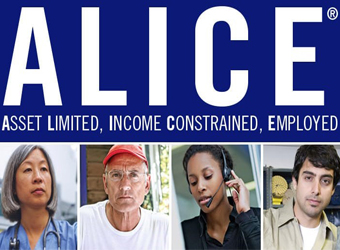 FCAN’s Kimberly Lent, Senior Research Associate, was recently joined by guest presenters Ted Granger, President of United Way of Florida, and Holly Bullard, interim Co-Executive Director at Florida Policy Institute and Florida ALICE Research Advisory Committee member, for a presentation about Floridians who struggle to make ends meet.
FCAN’s Kimberly Lent, Senior Research Associate, was recently joined by guest presenters Ted Granger, President of United Way of Florida, and Holly Bullard, interim Co-Executive Director at Florida Policy Institute and Florida ALICE Research Advisory Committee member, for a presentation about Floridians who struggle to make ends meet.
In the 2017-18 school year, 61.2% of Florida FAFSA filers — the third highest proportion in the nation — were eligible for a Pell Grant, a need-based federal student aid program. Students also deal with issues of food and housing insecurity. A recent Wisconsin Hope Center survey found 36% of university and 42% of community college students were food insecure in the past 30 days, and 36% of university and 46% of community college students were housing insecure in the past year.
Historically, communities have used federal poverty level rates to track the proportion of residents who are our most poor. However, the federal poverty rates are limited in what they can tell us about those who are living paycheck to paycheck and who might be one crisis away from falling into poverty. That’s where ALICE comes in.
Who is ALICE?
ALICE stands for Asset Limited, Income Constrained, Employed. These residents earn more than the federal poverty level, but less than it takes to survive in their community. Ted shared that ALICE workers are our hotel and restaurant staff, work at our daycares and school systems, and care for us and our families’ at doctors’ offices and hospitals. Ted also provided background for the United Way ALICE Project — an initiative taken on by United Ways in 16 states to better understand the needs of struggling residents and where organizations can target programming.
Holly highlighted the following Florida data points:
- In 2015, 29.5% of Florida households were ALICE and an additional 14.5% were below the federal poverty level.
- The proportion of ALICE and below poverty level Florida households has increased in the post-recession years, up from 24.9% and 11.3% in 2007, respectively.
- The average Florida household survival budget — the bare minimum needed to survive — increased by 19% from 2007 to 2015.
Attendees also got a sneak peek at data featured in the upcoming 2019 ALICE Report, including updated ALICE and poverty level rates and county level, year-to-year change in households living below the ALICE threshold.
Driving Change with ALICE
Communities around Florida are using ALICE data to inform their work and better serve their residents. Holly provided examples of ALICE used in advocacy efforts with Florida legislators and in data-driven work to geographically map where ALICE populations live in a given county. Additionally, communities have used ALICE in conversations with employers and the business community to help set local wages to a livable threshold and with service providers to redesign program eligibility criteria.
Updated ALICE Report Coming Soon
An updated ALICE Report will be available in early 2019. The new report will include data down to the zip code level and further address issues of Florida’s changing demographics, such as the impact of the growing retired, older adult population. The release will coincide with a press conference and statewide United Way advocacy efforts.
Show Notes:
Recording
Slides
2017 United Way ALICE Report
Link to downloadable ALICE Report data files
Be sure to visit our Past Webinars page for access to recordings and downloadable material from FCAN’s previous presentations.
